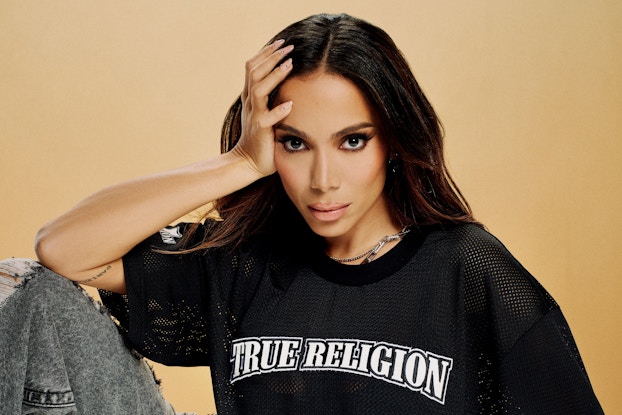
Why it matters:
- True Religion has been cooking up a comeback that courts Gen Z via authentic cultural moments with celebrities like musical artist Megan Thee Stallion and buzzy content creators across sports, entertainment, and fashion at events ranging from Coachella to NBA games.
- As the denim brand enhanced the product design of its women’s assortment, it’s benefited from a TikTok-nudged, nostalgia-fueled consumer interest in an early 2000s apparel aesthetic.
- CMO Kristen D’Arcy says the strategy is bearing fruit: True Religion exceeded its first quarter sales targets and is on track to generate $450 million in sales this year.
In 2023, rapper and recording artist Quavo and TV personality India Love opened up about style, family, and holiday gifting during denim giant True Religion’s first-ever holiday campaign. “Style is a Gift” featured the celebrities on the company’s e-commerce site, app, and social accounts. The campaign drove new traffic to both physical stores and to the True Religion website, said Kristen D’Arcy, who’s held the newly created role of Chief Marketing Officer at True Religion since 2023.
Quavo was a natural brand ambassador for the company. At age 15, he’d coveted the jeans that had become a streetwear staple since True Religion’s 2002 founding in Los Angeles. Known for its signature Super T stitching, Buddha imagery, and iconic horseshoe emblem, True Religion quickly earned a place in the wardrobes of hip-hop artists and Hollywood stars alike — appearing in music videos and on red carpets. Quavo even sketched a True Religion tattoo on his right arm, a personal homage to the brand he grew up admiring.

Interested in a small business membership?
Find out how the U.S. Chamber of Commerce can help your company grow and thrive in today's rapidly-evolving business environment. Connect with our team to learn how a small business membership can benefit your bottom line and help you achieve your goals.
“It’s somethin’ about those horseshoes on the back,” he told Hypebeast in 2023. “That symbol on the products just makes you feel like you spent a little bit more money than the next person.”
After the rapper’s True Religion contract was over, on Instagram, he still posted pictures of himself dressed head to toe in the brand.
“We reposted him and tagged him,” D’Arcy told CO—. “Then he DMed us back and said, ‘I love my True Religion family.’ He is the right partner all day long.”
It’s this type of close-knit, cultivated, yet authentic relationship with culturally-relevant celebrities and influencers who are passionate about the brand True Religion hopes will bring in millions of new customers — especially Gen Zers — and spark massive profits. The company is currently the most profitable it’s ever been, said D’Arcy. It exceeded its first quarter 2025 sales targets and is on track for 2025 sales of $450 million, she said.
“It’s been an incredible ride,” D’Arcy said, “and we’re confident we’re on the right and fairly quick trajectory to a billion in sales in total.”
True Religion is part of the $28.76 billion North American jeans market, projected to rise to $35.47 billion by 2030, according to Mordor Intelligence. In January, private equity firm Acon Investments purchased a controlling stake in True Religion in partnership with SB360 Capital Partners.
True Religion’s current growth strategy harkens back to its roots, when the brand landed at the center of music and sports.
After two bankruptcies, the brand brought back its logos and zeroed in on declining women’s sales
When Kim and Jeff Lubell founded True Religion in 2002, its jeans disrupted the denim market by reimagining the classic five-pocket jean with its signature stitch.
Then came the mid-2000s. Athleisure was taking off, and after a series of leadership changes, True Religion pulled its iconic logos from its products.
“The branding was much more subdued, if noticeable at all,” said D’Arcy. It was an unfortunate turning point. By 2017, True Religion was bankrupt.
The company emerged from bankruptcy, only to file again at the height of COVID. Since then, former True Religion CEO Michael Buckley returned to the brand.
“He did a couple of things right out of the gate,” D’Arcy said, including extensive consumer research. A key finding was that households under $100,000 in annual income preferred a logo-driven brand. So True Religion returned its iconic horseshoe logo and Buddha to products.

“We started bringing the product back to what it was before,” said D’Arcy. At the same time, it focused on women’s sales, a revenue stream that needed support — at the company’s heyday, women’s sales comprised 60% of sales, but over the years, it had fallen to just half of that. True Religion hired a new head of women’s product design who understood the company’s customer and started designing with her in mind.
The brand also lowered its price point to attract a broader swath of customers. Over a decade ago, shoppers could spend upward of $200 on a piece of True Religion apparel. Now, a pair of the brand’s jeans falls within the $100 range.
With the product tweaked, True Religion then turned to marketing.
Brand campaigns match cultural icons and touchpoints to authentically attract more Gen Z buyers
True Religion’s current growth strategy harkens back to its roots, when the brand landed at the center of music and sports. The Black Eyed Peas, Serena Williams, Britney Spears, and Paris Hilton all wore True Religion in its early days, said D’Arcy.
“If you’re walking down the street, you know it’s a True Religion product,” she said. Now, partnering with culturally relevant celebrities and influencers is a strategy the brand is actively going after to continue building itself up after its 2019 bankruptcy.
The company hones in on cultural touchpoints — celebrities and influencers across sports, music, fashion, and entertainment to connect to the brand — and it’s intentional about whom it chooses.
“It’s about picking the right people at the right time to be the face of the brand,” D’Arcy said. “We pick people we feel have a genuine love for this brand,” and especially those on the cutting edge of culture that are popular with Gen Zers.
True Religion tapped Grammy Award-winning artist Megan Thee Stallion for its 2024 holiday campaign, “Where Holiday Wishes Come True.” It featured the superstar musician in content, including connected TV, TikTok, Instagram, YouTube, Pinterest, Facebook, and audio.

And during the Super Bowl, True Religion launched a brand campaign and platform called “Own Your True” with content featuring Brazilian pop star Anitta. A 60-second kick off featuring Anitta dressed in True Religion tells the story of how the pop star has stayed true to her authentic self as she’s grown in popularity.
“She, too, is such a fan of the brand,” D’Archy said. “The campaign has outpaced our wildest expectations in terms of sales.”
The campaign, spanning social media, streaming, and audio marketing, is intended to ignite a cultural movement embracing individuality and self-expression, said D’Arcy, and it is woven into touchpoint events like the NBA’s All-Star Weekend and Coachella.
“For Coachella, we’re not only dressing her in custom looks, but we’re also outfitting all of her dancers. These relationships continue.”
[Read more: Key Solutions Retailers Are Focusing on to Drive Growth This Year]
Denim brands are relying on nostalgia to attract new customers
True Religion’s return comes at a highly competitive time for the denim market, says retail and apparel analyst Jane Hali, CEO of Jane Hali & Associates. It joins well-established, popular brands like AG Jeans and Levi’s, which are offering high-quality jeans.
“There’s a lot of interest in new denim styles — wide jeans, baggy jeans, barrel jeans,” said Hali. “And there’s a whole wardrobe that can be accumulated. But is True Religion the one people are going to turn to,” especially when consumers cognizant of a potential economic downturn are being more restrained with their apparel purchases?
At the same time, other denim brands are relying on celebrities and influencers important to modern culture and drawing on a sense of nostalgia too. For example, Levi’s is partnering with Beyoncé on its REIIMAGINE campaign, reinterpreting some of the brand’s iconic ads for the modern era.
True Religion, for its part, is hoping that consumers’ growing, TikTok-fueled interest in the early 2000s aesthetic will help set it apart. And it’s doubling down on its connections with creators and celebrities. The brand’s Team True brand ambassadors —rising and established creators and celebrities — further amplify its “Own Your True” platform with their own original content.
The Team True content creator platform launched last summer. Everyone from stylists to musicians to athletes receives new pieces from the True Religion collection monthly. They wear True Religion when styling celebrities or as they celebrate after winning an NBA game.
“They’re wearing us in a bold way,” D’Arcy said. “And we’re bringing them along to help power us authentically.”
As True Religion nurtures these relationships, they’re finding the celebrity and influencer endorsements build on themselves, and they’re starting to happen organically.
“You’ve got [actor] Timothée Chalamet wearing us multiple times, and Playboi Carti wearing us head to toe in a music video,” said D’Arcy.
D’Arcy, for one, is confident the brand’s celebrity-driven momentum will fuel the rapid growth of its e-commerce business and encourage customers to shop more frequently across its categories.
“We’re really trying to build up that basket size,” she said, and to extend the brand’s reach to more members of a household. “To then get to a billion plus in the next three to five years would be a great feather in our cap.”
CO— aims to bring you inspiration from leading respected experts. However, before making any business decision, you should consult a professional who can advise you based on your individual situation.
CO—is committed to helping you start, run and grow your small business. Learn more about the benefits of small business membership in the U.S. Chamber of Commerce, here.







